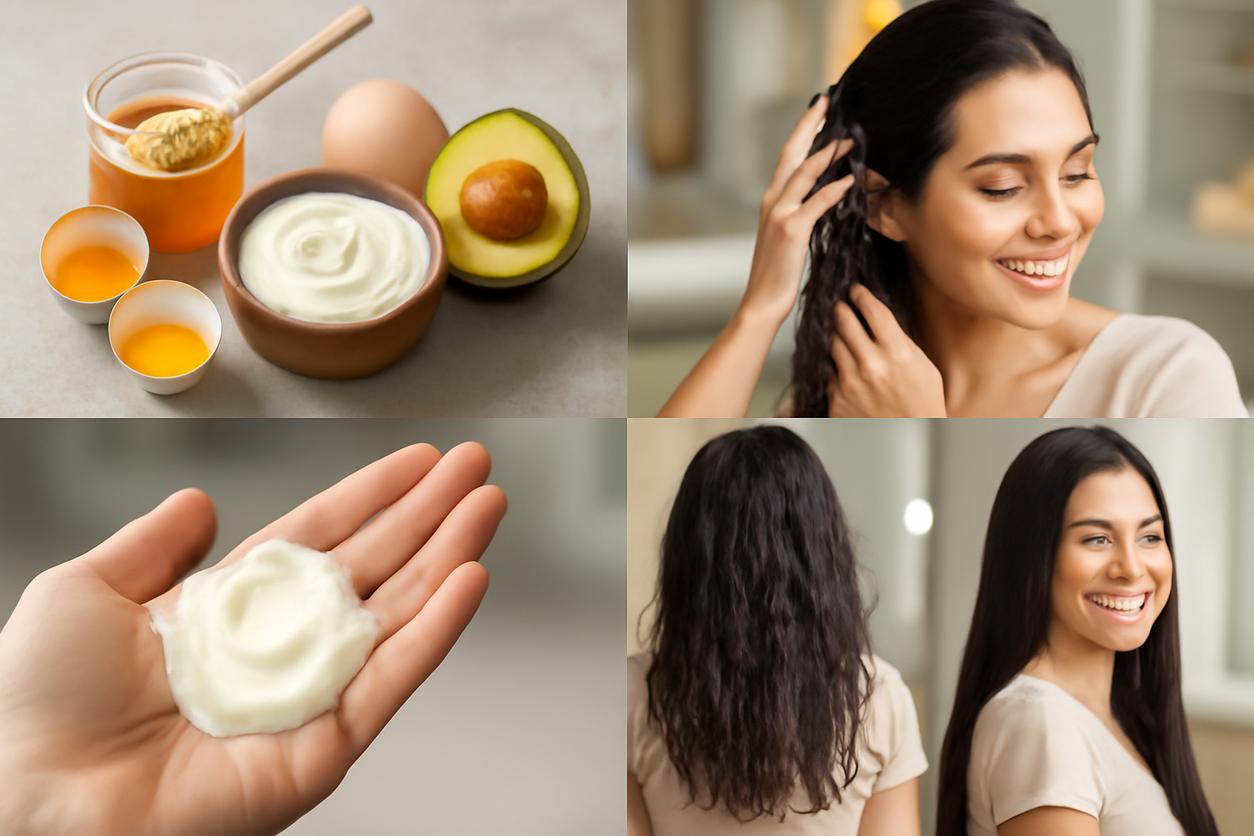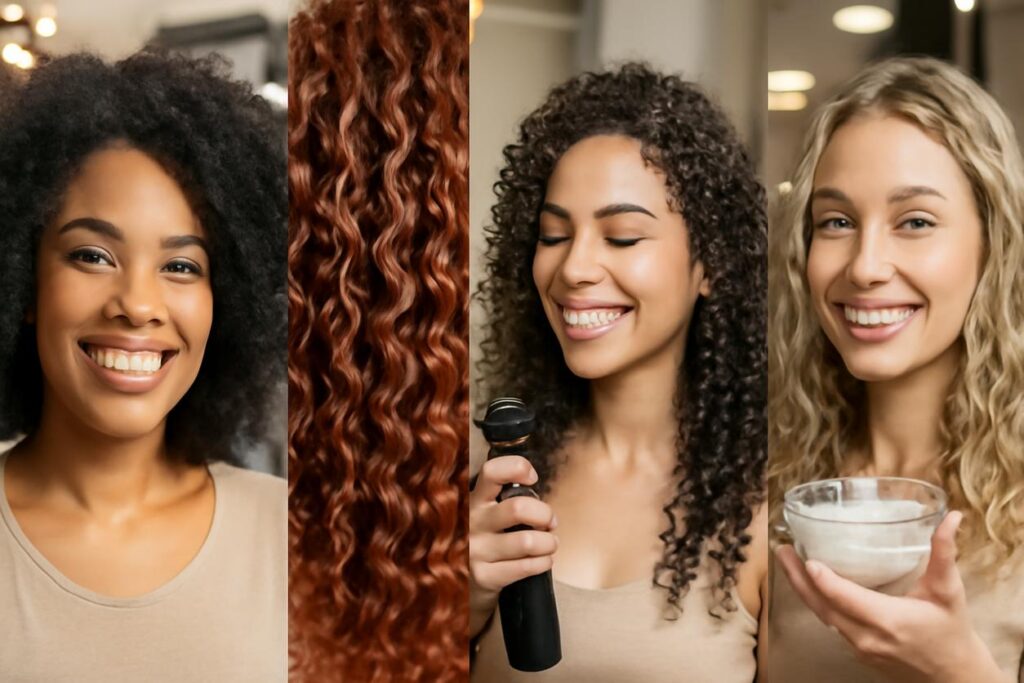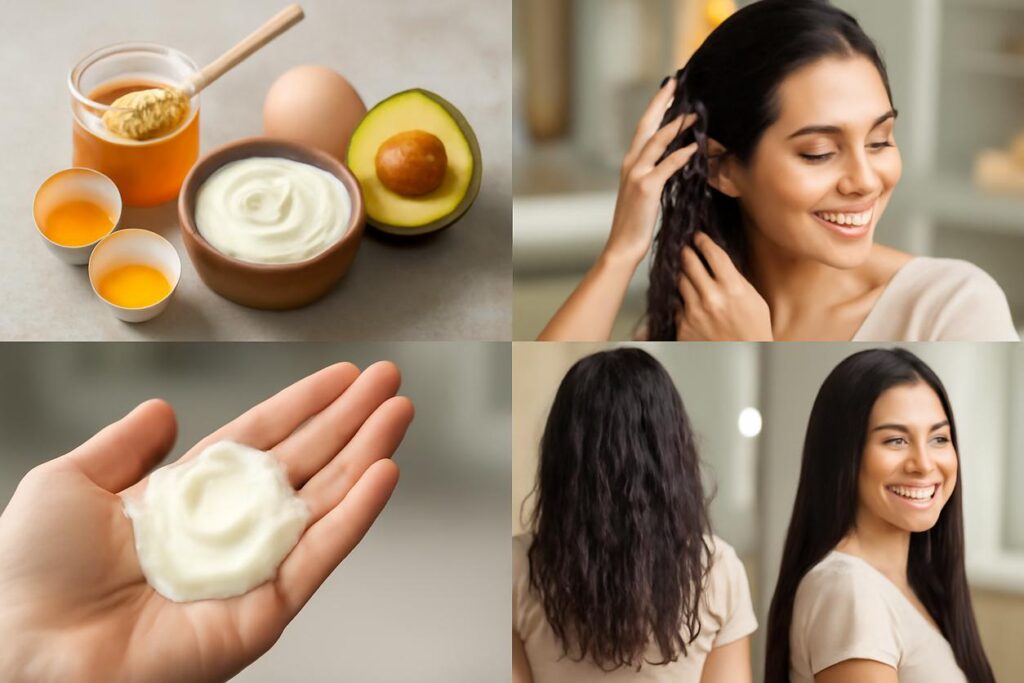The Ultimate 2025 Guide to DIY Hair Masks: Recipes for Every Hair Type
Table of Contents
- Introduction and What This Guide Covers
- How Hair Masks Work at the Hair Shaft Level
- Key Natural Ingredients Explained and Ratios
- Assessing Your Hair Type and Porosity
- Matching Mask Recipes to Hair Goals
- Tools and Measurements for Reliable DIY Results
- Step-by-Step Application and Timing
- Five Original DIY Hair Mask Recipes for Common Needs
- How Often to Use Masks and Long-Term Care Tips
- Safety, Allergy Checks, and Ingredient Storage
- Troubleshooting: When a Mask Leaves Residue or Heaviness
- FAQ: Quick Answers to Common Concerns
- References and Further Reading
Introduction and What This Guide Covers
Welcome to your complete guide to creating the perfect DIY hair mask right from your kitchen. If you dream of luscious, healthy hair without the hefty price tag of salon treatments, you are in the right place. A well-formulated DIY hair mask can deliver targeted nutrients to moisturize, strengthen, and add shine to your strands. This guide is designed for everyone, from absolute beginners to seasoned home hair care enthusiasts, offering a deep dive into the science and art of hair masks.
This comprehensive guide for 2025 and beyond will walk you through everything you need to know. We will cover how masks work, the best natural ingredients for your hair type, and how to accurately assess your hair’s porosity. Most importantly, you will find five original, easy-to-follow recipes tailored to specific hair goals—from deep moisture to protein repair. Get ready to transform your hair care routine and unlock the power of natural ingredients.
How Hair Masks Work at the Hair Shaft Level
To understand why a DIY hair mask is so effective, we need to look at the structure of a single hair strand. Each strand is primarily composed of a protein called keratin and has three main layers: the medulla (innermost), the cortex (middle), and the cuticle (outermost).
The cuticle is like a layer of protective shingles. When hair is damaged, dry, or exposed to harsh chemicals, these shingles lift, making the hair feel rough and look dull. When the cuticle is lifted, the hair is more prone to moisture loss and further damage.
A hair mask works by using ingredients with small enough molecules to penetrate the hair shaft or rich emollients to coat it.
- Penetrating Ingredients: Ingredients like coconut oil, aloe vera, and hydrolyzed proteins can get past the cuticle layer to nourish the inner cortex, improving hair’s strength and elasticity from within.
- Coating Ingredients: Thicker oils and butters, like shea butter or castor oil, work by sealing the cuticle. They form a protective barrier that smooths the lifted shingles, locking in moisture, reducing frizz, and adding a beautiful shine.
A great DIY hair mask often combines both types of ingredients to repair and protect, leaving your hair feeling soft, strong, and revitalized.
Key Natural Ingredients Explained and Ratios
The success of your DIY hair mask depends entirely on the ingredients you choose. Understanding their properties is key to creating a blend that works for you. Here are some of the most effective natural ingredients and a general ratio guide to get you started.
Common Kitchen Staples for Hair Health
| Ingredient | Primary Benefit | Best For | General Ratio (in a mask) |
|---|---|---|---|
| Avocado | Moisture, Healthy Fats, Vitamins | Dry, Damaged, Brittle Hair | 1/2 to 1 whole avocado (mashed) |
| Banana | Potassium, Silica (for strength), Moisture | Weak, Frizzy Hair | 1/2 to 1 whole banana (blended) |
| Yogurt (Plain, full-fat) | Lactic Acid (cleansing), Protein | Dull, Damaged Hair | 2-3 tablespoons |
| Egg | Protein (strength), Biotin | Brittle, Thin Hair (use yolk for moisture, white for oily scalp) | 1 whole egg |
| Honey (Raw) | Humectant (draws in moisture), Antibacterial | All Hair Types, especially Dry or Itchy Scalp | 1-2 tablespoons |
| Aloe Vera Gel (Pure) | Hydration, Scalp Soothing, Vitamins | All Hair Types, especially Dry Scalp or Low Porosity Hair | 2-3 tablespoons |
| Coconut Oil | Penetrating Moisture, Reduces Protein Loss | Dry, Damaged, High Porosity Hair | 1-2 tablespoons (melted) |
| Olive Oil | Sealing Moisture, Shine | Thick, Coarse, Dry Hair | 1-2 tablespoons |
Basic Ratio Guideline: A good starting point for any DIY hair mask is a 3:2:1 ratio: 3 parts base (like avocado or yogurt), 2 parts liquid/oil (like coconut oil or aloe vera), and 1 part active humectant (like honey).
Assessing Your Hair Type and Porosity
Before you start mixing, it is vital to understand your hair’s unique needs. The most critical factor for a successful DIY hair mask is hair porosity, which refers to your hair’s ability to absorb and retain moisture.
The Simple Float Test for Porosity
You can easily determine your hair’s porosity at home.
- Take a few clean, dry strands of your hair (from your brush is fine).
- Drop them into a glass of room temperature water.
- Observe what happens after a couple of minutes.
- Low Porosity: The hair floats at the top. This means your hair cuticles are tightly packed, making it difficult for moisture to get in. You need lightweight ingredients that will not cause buildup.
- Normal Porosity: The hair floats in the middle of the glass. Your cuticles are balanced, absorbing and retaining moisture well. Most masks will work for you.
- High Porosity: The hair sinks quickly to the bottom. Your cuticles are raised or have gaps, so your hair absorbs moisture easily but also loses it just as fast. You need richer ingredients to seal in hydration and protein to fill the gaps.
Matching Mask Recipes to Hair Goals
Now that you know your porosity, you can match ingredients and mask types to your specific goals.
For Deep Moisture
If your hair feels dry, rough, or straw-like (common with high porosity hair), your goal is hydration.
- Best Ingredients: Avocado, banana, honey, aloe vera, olive oil, and shea butter.
- Why: These ingredients are rich in humectants and emollients that draw in and seal moisture.
For Protein and Strength
If your hair is limp, brittle, or overly stretchy when wet (common with chemically treated or high porosity hair), it needs protein.
- Best Ingredients: Egg, Greek yogurt, gelatin, rice water.
- Why: These ingredients temporarily patch holes in the hair cuticle, reinforcing the strand’s structure. Caution: Too much protein can make hair stiff, especially for low porosity types.
For Shine and Clarity
If your hair looks dull or suffers from buildup (common with low porosity hair), your goal is to clarify and boost shine.
- Best Ingredients: Aloe vera, apple cider vinegar (heavily diluted), green tea, lightweight oils like grapeseed or jojoba oil.
- Why: These ingredients cleanse the scalp and smooth the hair cuticle without weighing it down, reflecting more light.
Tools and Measurements for Reliable DIY Results
Consistency is key for a great DIY hair mask. Using the right tools ensures your mask has the perfect texture for easy application and delivers predictable results every time.
- Non-metallic bowl: To mix your ingredients without any potential reaction. A simple glass or plastic bowl is perfect.
- Whisk, fork, or small blender: For a smooth, lump-free consistency. A blender is especially useful for ingredients like banana or avocado.
- Measuring spoons and cups: To ensure you are using the right ratios.
- Shower cap or plastic wrap: To trap heat from your scalp, which helps the mask penetrate more effectively.
- An old t-shirt or towel: To protect your clothes during application.
Step-by-Step Application and Timing
Applying your homemade mask correctly is just as important as the recipe itself. Follow these steps for the best results.
- Prepare Your Hair: It is often best to apply a DIY hair mask to clean, damp hair. Shampoo your hair, gently towel-dry it until it is no longer dripping, and then comb through any tangles. Applying to dry hair can also work, especially for very thick oil-based masks.
- Mix Your Mask: Prepare your chosen recipe right before you plan to use it for maximum freshness and potency.
- Apply in Sections: Divide your hair into 4-6 manageable sections. Apply the mask generously from roots to ends, using your fingers to work it into the strands. Pay extra attention to the ends, which are usually the driest part of the hair.
- Cover and Wait: Once your hair is fully saturated, twist it up and cover it with a shower cap. Let the mask sit for 20-30 minutes. For an extra-deep conditioning treatment, you can wrap a warm towel around the shower cap.
- Rinse Thoroughly: Rinse the mask out completely with lukewarm water. This may take a few minutes, especially for thicker, oil-based masks.
- Condition (Optional but Recommended): Follow up with your regular conditioner. This helps to seal the hair cuticle and lock in all the benefits of the mask.
Five Original DIY Hair Mask Recipes for Common Needs
Here are five tried-and-true recipes. Remember to blend any solid ingredients thoroughly to avoid leaving chunks in your hair.
1. The Ultimate Moisture Mask (For High Porosity and Dry Hair)
- Ingredients: 1/2 ripe avocado, 1/2 ripe banana, 1 tablespoon olive oil, 1 tablespoon honey.
- Instructions: Blend all ingredients until completely smooth. Apply to damp hair, focusing on the ends. Leave on for 30 minutes, then rinse thoroughly. This DIY hair mask is packed with fats and humectants to deeply hydrate thirsty strands.
2. The Strengthening Protein Mask (For Damaged, Brittle Hair)
- Ingredients: 1 egg, 3 tablespoons plain Greek yogurt, 1 tablespoon coconut oil (melted).
- Instructions: Whisk the egg and yogurt together, then slowly whisk in the melted coconut oil. Apply to hair from root to tip. Leave on for no more than 20 minutes (protein can make hair stiff if left too long). Rinse with cool water to avoid cooking the egg.
3. The Shine-Boosting Elixir (For Low Porosity and Dull Hair)
- Ingredients: 3 tablespoons pure aloe vera gel, 1 tablespoon honey, 1 tablespoon grapeseed or argan oil.
- Instructions: Mix all ingredients until well combined. This mask is lightweight and will not cause buildup. Apply to clean, damp hair. Leave on for 20 minutes, then rinse.
4. The Soothing Scalp Treatment (For Itchy or Flaky Scalp)
- Ingredients: 1/4 cup colloidal oatmeal (finely ground oats), 1/2 cup warm water or green tea, 1 tablespoon honey.
- Instructions: Mix the oatmeal and warm liquid until it forms a paste. Stir in the honey. Apply directly to the scalp, gently massaging it in. Let it sit for 20 minutes before rinsing carefully.
5. The All-Rounder Balancing Mask (For Normal Porosity Hair)
- Ingredients: 1/4 cup full-fat coconut milk, 2 tablespoons aloe vera gel, 1 tablespoon olive oil.
- Instructions: Whisk ingredients together. This mask provides a perfect balance of light moisture and nutrients. Apply to hair and leave for 20-30 minutes before rinsing.
How Often to Use Masks and Long-Term Care Tips
For most hair types, using a DIY hair mask once a week is a great routine. However, you should always listen to your hair.
- Very dry or damaged hair: May benefit from twice-weekly treatments initially.
- Fine or oily hair: May only need a mask every two weeks to avoid weighing hair down.
- Protein masks: Should be used more sparingly, typically once or twice a month, to prevent protein overload.
Long-term care involves consistency. A regular masking routine, combined with gentle hair handling, a balanced diet, and minimal heat styling, will yield the best results for hair health.
Safety, Allergy Checks, and Ingredient Storage
Even natural ingredients can cause reactions. Before applying any new DIY hair mask to your entire head, perform a patch test.
- How to Patch Test: Apply a small amount of the mask mixture to a discreet area of skin, like behind your ear or on your inner elbow. Wait 24 hours to check for any signs of redness, itching, or irritation.
Ingredient Storage: Because these masks are made with fresh food ingredients, they are highly perishable. You should always make a fresh batch for each use and discard any leftovers immediately. They do not contain preservatives and can grow bacteria quickly.
Troubleshooting: When a Mask Leaves Residue or Heaviness
Sometimes, a DIY hair mask does not go as planned. Here is how to fix common issues.
- Hair feels greasy or weighed down: This usually means the mask was too heavy for your hair type (e.g., too much oil for low porosity hair) or it was not rinsed out properly. Try rinsing again, or use a gentle clarifying shampoo. Next time, reduce the amount of oil or butter in your recipe.
- Hair feels stiff or brittle: This is a classic sign of protein overload. Your hair has too much protein and not enough moisture. Use a simple moisturizing mask (like the Ultimate Moisture Mask above) at your next wash to restore balance.
- You see no difference: The recipe might not be the right fit for your hair’s porosity. Re-evaluate your hair type and try a different combination of ingredients. It can take a little experimentation to find your perfect DIY hair mask.
FAQ: Quick Answers to Common Concerns
Can I sleep with a DIY hair mask in my hair?
It is generally not recommended to sleep in a mask made with fresh, wet ingredients like fruit or yogurt. This can create a breeding ground for bacteria on your scalp. Oil-only treatments (like pure coconut oil) are safer for overnight use.
Should I apply the mask to wet, damp, or dry hair?
Damp hair is usually the sweet spot. It is clean and the cuticle is slightly open, making it receptive to the mask’s nutrients. Dry hair can work for oil-heavy masks, while wet hair can dilute the mixture too much.
Can a DIY hair mask help with hair growth?
Indirectly, yes. While a mask will not magically make your hair grow faster, ingredients that improve scalp health (like those in the Soothing Scalp Treatment) create a better environment for healthy hair growth. By strengthening the hair shaft, masks also reduce breakage, which helps you retain length.
References and Further Reading
For more in-depth information on hair health and science, we recommend these reputable sources:
- NHS Hair Guidance: For medical information regarding hair conditions.
- American Academy of Dermatology: Expert advice on hair health and loss.
- PubMed: For scientific research on hair nutrition and treatments.
- DermNet NZ: A comprehensive resource on trichology (the study of hair and scalp).
- The Trichology Association: Professional insights into hair and scalp care.





